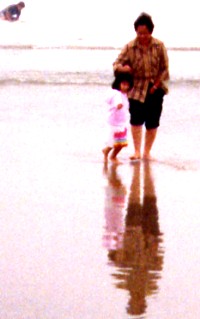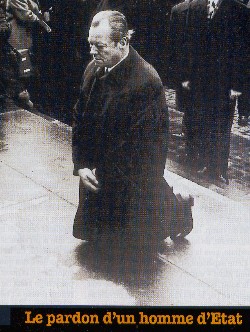
Nguyễn Quốc Trụ
phụ trách
THỜI SỰ
|
Lest
we forget
Sixty
years on, books from Laurence Rees and Sybille Steinbacher examine
Auschwitz and the depravity of the Final Solution
Neal
Ascherson
Sunday January 16, 2005
The Observer
Auschwitz:
The Nazis and the Final Solution by Laurence Rees (BBC Books, £20,
pp320)
Auschwitz by Sybille Steinbacher (Penguin £6.99,
pp168)
When I first
went to Auschwitz,
the
earth was still white with calcined bone, while thousands of rusting
spoons and
forks lay on the site of the storehouses. Today, the earth is normal
brown, the
spoons have gone and the scrawny poplars planted by the SS to hide the
gas
chambers have become tall and beautiful. Nature wants us to forget, but
human
beings want to know everything that happened here and then fix it
unalterably
in the memory of our species.
Half the British population, apparently, have never heard of Auschwitz.
Some of the other half
think that there is
nothing left to say about it.
Khi tôi
tới
Auschwitz lần đầu, đất trắng mầu xương người bị
thiêu... Giờ đây đất đã trở lại mầu nâu bình thường... Thiên nhiên muốn
con người quên, nhưng con người muốn hiểu rõ mọi chuyện đã xẩy ra ở
đây, và gắn chặt mãi nó vào trong hồi ức của cái giống người.
Simon
Jeffery and agencies
Thursday January 13, 2005
Prince Harry was today urged to visit Auschwitz
after his apology for wearing a Nazi officer's uniform to a fancy dress
party
appeared to do little to calm the controversy.
[Trích Guardian]
Hoàng tử Harry, con Diana, được yêu
cầu hãy đến Lò Thiêu mà
xin lỗi, sau khi diện bộ đồ Nazi

Thủ Tướng Đức quỳ xin lỗi
Số tù khắc,
trạm, trổ lên
da
Sáu mươi năm
sau khi được
giải phóng, Simone Viel đưa mấy đứa cháu tới Lò Thiêu:
"Ở đó, tôi
chưa bao giờ khóc. Nó vượt quá những giọt nước mắt."
Báo Người Quan sát Mới: Ngày 27
Tháng Giêng 1945, quân đội Xô Viết
đã giải phóng Auschwitz. Họ tìm thấy gì ở đó?
Annette
Wieviorka: Nói giải phóng là
không đúng. Tiền quân Hồng Quân tình cờ khám phá ra trại tù. Họ không
tìm kiếm. Hàng ngàn người hấp hối, bị bỏ mặc tại chỗ. Những ngưòi còn
sức, thì bị bắt đi, trong cuộc đi bộ
của tử thần. Chiến tranh đã chấm dứt đâu, vẫn cần người còn sức làm
việc.
Sixty years
on, we are still trying to understand the
Holocaust. Studies of Auschwitz from Laurence
Rees and
Sybille Steinbacher provide a valuable record, says Ian Thomson
Saturday January 29, 2005 The
Guardian
Auschwitz: The
Nazis and the Final
Solution
by Laurence
Rees
320pp, BBC, £20
Auschwitz: A History
by Sybille
Steinbacher, translated by Shaun Whiteside
168pp,
Penguin, £6.99
Auschwitz was not a single camp; 39
satellite camps formed a malignant universe. The main camp at Auschwitz
I was the administrative centre; Auschwitz II was the extermination
centre;
Auschwitz III was a hybrid death-and-work camp. Numerous German
companies
exploited the presence of Jews at Auschwitz.
Among them
were Bayer, Agfa, BASF and Pelikan (which provided the ink to tattoo
prisoners). So the camp operated as an industrial, as well as an
extermination
centre, whose factories used unpaid slave labour. Incredibly, the
synthetic-rubber factory which Jewish prisoners built at Auschwitz III
is still
in operation
Sáu mươi năm
sau, con người vẫn tìm cách hiểu Auschwitz,
ghê rợn của ghê rợn. Auschwitz không phải trần
một trại,
mà cả một vũ trụ, với 39 trại vệ tinh. Aus 1, hành chính, 2, trung tâm
làm
thịt, 3, làm tới chết. Nhiều công ty Đức khai thác. Bayer, Agfa... và
Pelikan
[cung cấp mực xâm số tù]. Như thế, lò làm thịt người này còn là một
trung tâm
kỹ nghệ với những kho xường sử dụng công nhân viên trả tiền bằng chính
cái chết
của họ. Thú nhất là, xưởng cao su, do tù dựng lên, bây giờ vưỡn hoạt
động. Hiện
có cả một tiệm cà phê ở nghĩa địa của nhân loại này.
Gấu cứ nghĩ
đến nghĩa địa voi, cái giống vật rất ư là thông
minh...
|


